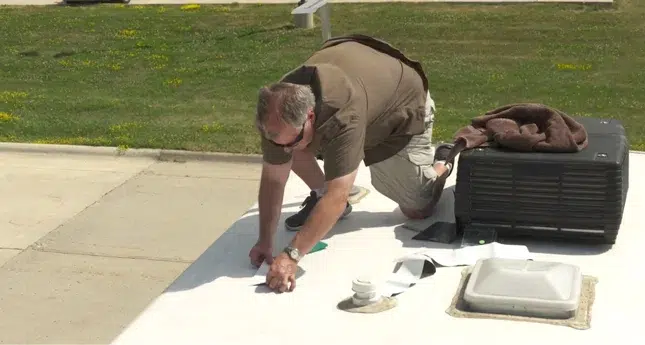Last Updated on May 1, 2023
A TPO roof is a type of roofing material made of rubber membrane. The material is commonly used on RVs because of its durability and ability to withstand extreme weather conditions. To assure that TPO roofs remain in good condition, as with all roofing materials, they need to be adequately maintained.
How to maintain TPO RV roof is, therefore, a must-know factor for RV owners. When properly maintained, TPO roofs can last longers and will protect your RV from the elements. To ensure this happens, you should learn how to keep the roof properly.
The majority of people believe that the rubber roof does not require cleaning and there is nothing else to worry about. But TPO roofs need to be checked and cleaned regularly. Let’s explore this in detail below.
How to Maintain TPO RV Roof in Some Easy Steps
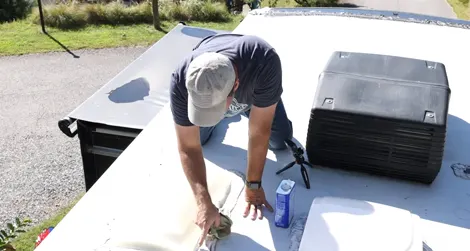
TPO roofing is one of the most popular roofing system for the RV. Their durability and ability to withstand extreme weather conditions are well known. However, general rules for maintaining any roof still apply to TPO rubber roofs.
Following are some easy steps on how to maintain your TPO roof:
Step 01. Check for Debris and Clean the Surface:
The first step is to check the roof’s surface for any debris. This can be anything from leaves and branches to dirt and dust. Once the trash is located, use a broom or brush to remove it.
Step 02: Inspect the Seams and Flashings:
After cleaning the roof’s surface, it is time to examine the seams and flashings. These are the areas where most leaks occur. If you see cracks or holes, use a sealant to repair them. Avoid using tape as a sealant as it will not last long.
Step 03: Check the Drainage System:
The next step is checking the drainage system. This includes the gutters, downspouts, and drains. Make sure they are clear of debris and functioning properly. If you see any problems, call a professional to repair them.
Step 04: Apply Protective Coating to RV Roofs:
After checking and repairing all the areas mentioned above, it is time to apply a protective coating. This will help to extend the life of your roof. There are many different types of coatings available on the market.
Choose one that is designed explicitly for TPO roofs. Follow the instructions on the label and apply the coating evenly. It is best to use self-leveling sealant for this job.
Step 05: Repair Any Punctures or Holes Immediately:
If you notice any punctures or holes in your roof, it is crucial to repair them immediately. Use a sealant to fill the holes and then apply a protective coating over the top.
These are just a few of the things that you need to do to maintain your TPO roof. By following these simple steps, you can extend the life of your roof and avoid costly repairs.
Try to inspect your roof and clean it of any debris regularly. This will help keep it in good condition and prevent any problems in the future.
Importance of a Regular RV Roof Maintenance Schedule
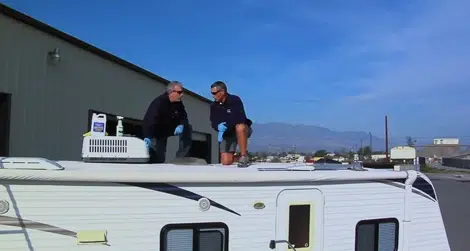
It is vital to have a regular TPO roof maintenance schedule for your TPO roof. This will help keep it in good condition and prevent any problems.
A regular RV roof maintenance schedule should include:
- Check the roof for any leaks or damage.
- Inspect the seams and flashings for any damage or leaks.
- Checking the gutters and downspouts for any debris or blockages.
- Trimming back any trees or shrubs that are touching the roof.
- Cleaning the roof surface of any dirt or debris.
- Inspect the roof ventilation to ensure it is working correctly.
- Checking the condition of the roof membrane.
- Scheduling an annual professional inspection of the roof.
A regular maintenance schedule will help keep your TPO roof in good condition and prevent any problems. By following this schedule, you can be sure that your roof will last longer.
Additional Advice on Cleaning RV TPO Roof
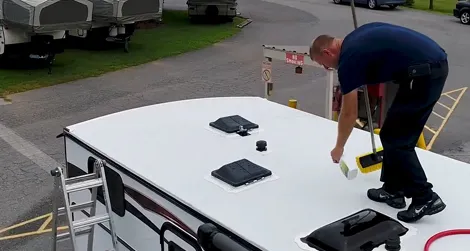
It is important to clean your RV TPO roof regularly. This will help prevent any build-up of dirt or debris and extend the life of your roof. The followings are some tips on how to clean your TPO roof:
Use Only Non-Corrosive Rubber Cleaners:
When cleaning your RV TPO roof, it is essential to use only non-corrosive rubber cleaners. These cleaners are specifically designed for RV TPO roofs and will not damage the surface.
Avoid using citrus-based solvents on TPO roofs because they can corrode the material and cause the finish to flake. The removal of thick, sticky sap residue can be accomplished by using mineral spirits and a soft brush.
Use a Soft Bristle Brush:
When cleaning the surface of your roof, it is best to use a soft bristle brush. This will help to avoid any damage to the roof.
Avoid Pressure Washing:
Pressure washing is not recommended for cleaning RV TPO roofs. The high pressure of the water can damage the surface of the roof.
If you must use a low-pressure power washer, use a low-pressure setting and hold the wand at least 12 inches away from the roof’s surface.
Roof Scrub in Small Sections:
When scrubbing the roof, it is best to work in small sections. This will help to avoid any streaking on the surface of the roof. Additionally, it is essential to rinse the roof thoroughly after scrubbing to remove any cleaner left behind.
If you follow these simple tips, you can keep your TPO roof clean and extend its life. By regularly cleaning your roof, you can avoid any build-up of dirt or debris and prevent any future damage from occurring.
Types of RV Roofing Materials
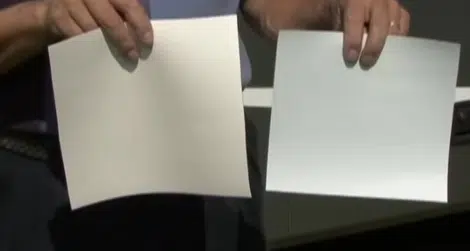
There may be some confusion regarding the materials used to make RV roofs. A roof’s type will significantly impact how you maintain it, so you must choose the right one for your situation. Common RV roof materials include:
01. Thermoplastic Polyolefin (TPO):
TPO or Thermoplastic Polyolefin is a single-ply rubber membrane made of a blend of polypropylene and ethylene-propylene rubber. It is white and is often used on commercial roofs.
TPO roofing is known for its durability and resistance to UV rays, making them a good choice for RVers who travel in sunny locations.
You can easily walk on TPO when wet since it is not slippery, and if you pull off the vent shroud, white roof material should be seen on the underside. Furthermore, TPO tends to exhibit a higher shine.
02. Ethylene Propylene Diene Monomer (EPDM):
EPDM is a synthetic rubber membrane that is made of ethylene and propylene. It is black in color and has a smooth, glossy surface. EPDM roofs are trendy on RVs since they are easy to install and are very durable.
These roofs can be walked on when wet, and they are also resistant to UV rays. However, they can be damaged by chemicals, so it is important to avoid using any harsh cleaners on them. If you pull off the vent shroud, black material should be seen on the underside.
03. Almunium:
Aluminum roofs are made of, well, aluminum. They are often used on commercial buildings and are very durable. Aluminum roofs are reflective, so they can help to keep your RV cooler in sunny weather.
When wet, these roofs can be walked on, but chemicals can damage them. If you pull off the vent shroud, metal roofs material should be seen on the underside.
04. Fiberglass:
Fiberglass roofs are made of, you guessed it, fiberglass. They are often used in RVs and are known for being lightweight and easy to install. Fiberglass roofs are white in color and have a smooth, glossy surface.
These roofs can be walked on when wet, but they are not as durable as some of the other options. White material should be seen on the underside if you pull off the vent shroud.
These are the most common types of RV roofs. It is important to choose the right one for your situation. If you are unsure, you can always consult with a professional to get the best advice.
FAQs
Let’s look at some of the most frequently asked questions about RV roofs”
01. How Often Should I Clean My RV Roof?
It is generally recommended that you clean your RV roof every three months. However, this may vary depending on your specific situation. If you live in a dry climate, you may not need to clean as often. Conversely, if you live in a wet or humid environment, you may need to clean more often.
02. How Long Does an RV TPO Roof Last?
TPO roofs are durable and can last 10 to 20 years, depending on the environment and care. If you maintain your roof correctly, it will last longer.
03. What Should I Use to Clean My TPO RV Roof?
You should use a mild, non-abrasive household detergent and water cleaning solution to clean your TPO roof. The surface of the TPO roofing systems should be cleaned using a floor broom or a soft-bristled, long-handled brush. Avoid using any harsh chemicals or cleaners as this can damage the roof.
04. Can You Use Flex Seal on a TPO RV roof?
A: If your roof is made with fiberglass, EPDM rubber, metal, and TPO, then you are safe to use Flex Seal. However, if your roof is made with PVC, you should not use Flex Seal as it can damage the material.
In Conclusion
Various roofing options are available for RVs, and each one has its advantages and disadvantages. The TPO RV roof is among the most popular options because it is long-lasting and easy to install and maintain.
So if you have a TPO RV roof, be sure to maintain it properly to get the most out of it. With these tips in mind, you can extend the life of your roof and keep it looking stunning for many years to come.
Hopefully, the information provided in this article has helped you to learn how to maintain TPO RV roof. For any further questions, be sure to consult a professional.

